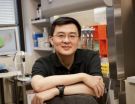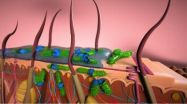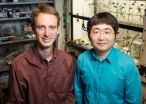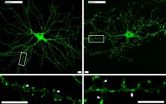(Press-News.org) (SACRAMENTO, Calif.) — Kit Lam and colleagues from UC Davis and other institutions have created dynamic nanoparticles (NPs) that could provide an arsenal of applications to diagnose and treat cancer. Built on an easy-to-make polymer, these particles can be used as contrast agents to light up tumors for MRI and PET scans or deliver chemo and other therapies to destroy tumors. In addition, the particles are biocompatible and have shown no toxicity. The study was published online today in Nature Communications.
"These are amazingly useful particles," noted co-first author Yuanpei Li, a research faculty member in the Lam laboratory. "As a contrast agent, they make tumors easier to see on MRI and other scans. We can also use them as vehicles to deliver chemotherapy directly to tumors; apply light to make the nanoparticles release singlet oxygen (photodynamic therapy) or use a laser to heat them (photothermal therapy) – all proven ways to destroy tumors."
Jessica Tucker, program director of Drug and Gene Delivery and Devices at the National Institute of Biomedical Imaging and Bioengineering, which is part of the National Institutes of Health, said the approach outlined in the study has the ability to combine both imaging and therapeutic applications in a single platform, which has been difficult to achieve, especially in an organic, and therefore biocompatible, vehicle.
"This is especially valuable in cancer treatment, where targeted treatment to tumor cells, and the reduction of lethal effects in normal cells, is so critical," she added.
Though not the first nanoparticles, these may be the most versatile. Other particles are good at some tasks but not others. Non-organic particles, such as quantum dots or gold-based materials, work well as diagnostic tools but have safety issues. Organic probes are biocompatible and can deliver drugs but lack imaging or phototherapy applications.
Built on a porphyrin/cholic acid polymer, the nanoparticles are simple to make and perform well in the body. Porphyrins are common organic compounds. Cholic acid is produced by the liver. The basic nanoparticles are 21 nanometers wide (a nanometer is one-billionth of a meter).
To further stabilize the particles, the researchers added the amino acid cysteine (creating CNPs), which prevents them from prematurely releasing their therapeutic payload when exposed to blood proteins and other barriers. At 32 nanometers, CNPs are ideally sized to penetrate tumors, accumulating among cancer cells while sparing healthy tissue.
In the study, the team tested the nanoparticles, both in vitro and in vivo, for a wide range of tasks. On the therapeutic side, CNPs effectively transported anti-cancer drugs, such as doxorubicin. Even when kept in blood for many hours, CNPs only released small amounts of the drug; however, when exposed to light or agents such as glutathione, they readily released their payloads. The ability to precisely control chemotherapy release inside tumors could greatly reduce toxicity. CNPs carrying doxorubicin provided excellent cancer control in animals, with minimal side effects.
CNPs also can be configured to respond to light, producing singlet oxygen, reactive molecules that destroy tumor cells. They can also generate heat when hit with laser light. Significantly, CNPs can perform either task when exposed to a single wavelength of light.
CNPs offer a number of advantages to enhance imaging. They readily chelate imaging agents and can remain in the body for long periods. In animal studies, CNPs congregated in tumors, making them easier to read on an MRI. Because CNPs accumulated in tumors, and not so much in normal tissue, they dramatically enhanced tumor contrast for MRI and may also be promising for PET-MRI scans.
This versatility provides multiple options for clinicians, as they mix and match applications.
"These particles can combine imaging and therapeutics," said Li. "We could potentially use them to simultaneously deliver treatment and monitor treatment efficacy."
"These particles can also be used as optical probes for image-guided surgery," said Lam. "In addition, they can be used as highly potent photosensitizing agents for intraoperative phototherapy."
While early results are promising, there is still a long way to go before CNPs can enter the clinic. The Lam lab and its collaborators will pursue preclinical studies and, if all goes well, proceed to human trials. In the meantime, the team is excited about these capabilities.
"This is the first nanoparticle to perform so many different jobs," said Li. "From delivering chemo, photodynamic and photothermal therapies to enhancing diagnostic imaging, it's the complete package."
INFORMATION:
Other researchers included Tzu-yin Lin, Yan Luo, Qiangqiang Liu, Wenwu Xiao, Wenchang Gu1, Diana Lac, Hongyong Zhang, Caihong Feng, Sebastian Wachsmann-Hogiu, Jeffrey H. Walton, Simon R. Cherry, Douglas J. Rowland, David Kukis and Chongxian Pan.
This research was funded by the National Cancer Institute (grants R01CA115483 and R01CA140449), National Institute of Biomedical Imaging and Bioengineering (grant R01EB012569), the Department of Defense (grant W81XWH-12-1-008), the Prostate Cancer Foundation, the Veterans Administration and the California Institute for Regenerative Medicine.
UC Davis Comprehensive Cancer Center is the only National Cancer Institute-designated center serving the Central Valley and inland Northern California, a region of more than 6 million people. Its specialists provide compassionate, comprehensive care for more than 10,000 adults and children every year, and access to more than 150 clinical trials at any given time. Its innovative research program engages more than 280 scientists at UC Davis, Lawrence Livermore National Laboratory and Jackson Laboratory (JAX West), whose scientific partnerships advance discovery of new tools to diagnose and treat cancer. Through the Cancer Care Network, UC Davis collaborates with a number of hospitals and clinical centers throughout the Central Valley and Northern California regions to offer the latest cancer care. Its community-based outreach and education programs address disparities in cancer outcomes across diverse populations. For more information, visit cancer.ucdavis.edu.
Introducing the multi-tasking nanoparticle
Versatile particles offer a wide variety of diagnostic and therapeutic applications
2014-08-26
ELSE PRESS RELEASES FROM THIS DATE:
HIV antibodies block infection by reservoir-derived virus in laboratory study
2014-08-26
WHAT:
A laboratory study led by scientists from the National Institute of Allergy and Infectious Diseases, part of the National Institutes of Health (NIH), lends further weight to the potential effectiveness of passive immunotherapy to suppress HIV in the absence of drug treatment. Passive immunotherapy for HIV is an experimental strategy that involves periodically administering broadly neutralizing HIV-specific antibodies (bNAbs) to control the virus. It would be advantageous to control HIV without antiretroviral drugs because of their cost, the potential for cumulative ...
Breakthrough antibacterial approach could resolve serious skin infections
2014-08-26
Like a protective tent over a colony of harmful bacteria, biofilms make the treatment of skin infections especially difficult. Microorganisms protected in a biofilm pose a significant health risk due to their antibiotic resistance and recalcitrance to treatment, and biofilm-protected bacteria account for some 80 percent of total bacterial infections in humans and are 50 to 1,000 times more resistant to antibiotics than simpler bacterial infections.
"In essence, we may have stumbled onto a magic bullet," said David Fox, a Los Alamos National Laboratory researcher on the ...
Scientists craft atomically seamless, thinnest-possible semiconductor junctions
2014-08-26
Scientists have developed what they believe is the thinnest-possible semiconductor, a new class of nanoscale materials made in sheets only three atoms thick.
The University of Washington researchers have demonstrated that two of these single-layer semiconductor materials can be connected in an atomically seamless fashion known as a heterojunction. This result could be the basis for next-generation flexible and transparent computing, better light-emitting diodes, or LEDs, and solar technologies.
"Heterojunctions are fundamental elements of electronic and photonic devices," ...
Personal protective equipment is critical but not enough to shield health care workers from Ebola
2014-08-26
Personal protective equipment is critical but not enough to shield health care workers from Ebola*
Free content
Personal protective equipment designed to shield health care workers from contaminated body fluids of Ebola patients is not enough to prevent transmission, according to a commentary being published early online today in Annals of Internal Medicine. Despite the known effectiveness of barrier protection in blocking Ebola transmission, infections among health care workers have played a major role in outbreaks. William A. Fischer II, MD from the University of North ...
Challenges ahead in improving child health by increasing access to sanitation in India
2014-08-26
A study published in this week's PLOS Medicine on large-scale rural sanitation programs in India highlights challenges in achieving sufficient access to latrines and reduction in open defecation to yield significant health benefits for young children.
The researchers, led by Sumeet Patil from the School of Public Health, University of California at Berkeley, and the Network for Engineering and Economics Research and Management in Mumbai, India conducted a cluster randomised controlled trial in 80 rural villages in the Indian state of Madhya Pradesh to measure the effect ...
A glucose meter of a different color provides continuous monitoring
2014-08-26
CHAMPAIGN, Ill. — University of Illinois engineers are bringing a touch of color to glucose monitoring.
The researchers developed a new continuous glucose monitoring material that changes color as glucose levels fluctuate, and the wavelength shift is so precise that doctors and patients may be able to use it for automatic insulin dosing - something not possible using current point measurements like test strips.
"There are significant limitations to current continuous glucose monitoring technologies," said study leader Paul Braun, a professor of materials science and ...
NASA's TRMM and Aqua satellites gaze into Hurricane Cristobal
2014-08-26
NASA's TRMM and Aqua satellites have been providing views of the outside and inside of Hurricane Cristobal as it heads for Bermuda. The National Hurricane Center posted a Tropical Storm Watch for Bermuda as Cristobal heads in that direction.
Strong winds and flooding associated with Tropical Storm Cristobal caused deaths in the Dominican Republic, Haiti, and Jamaica. The Tropical Rainfall Measuring Mission or TRMM satellite captured rainfall data from Cristobal on August 24, 2014 at 1150Z (7:50 a.m. EDT). Light to moderate rainfall was occurring throughout much of the ...
Satellite shows Hurricane Marie about to swallow Karina
2014-08-26
Massive Hurricane Marie appears like a giant fish about to swallow tiny Tropical Depression Karina on satellite imagery today from NOAA's GOES-West satellite. Karina, now a tropical depression is being swept into Marie's circulation where it is expected to be eaten, or absorbed.
An image from NOAA's GOES-West satellite on Aug. 26 at 8 a.m. EDT shows Karina being drawn into the powerful and large circulation of Hurricane Marie to the east of the depression. The image was created by NASA/NOAA's GOES Project at NASA's Goddard Space Flight Center in Greenbelt, Maryland.
Forecasters ...
NASA sees huge Hurricane Marie slam Socorro Island
2014-08-26
NASA's Terra satellite passed over Hurricane Marie when its eye was just to the west of Socorro Island in the Eastern Pacific. Marie's eye may have been near the island, but the storm extended several hundreds of miles from there.
On Aug. 25 at 18:20 UTC (2:20 p.m. EDT) the Moderate Resolution Imaging Spectroradiometer or MODIS instrument aboard NASA's Terra satellite captured Hurricane Marie's center just west of Socorro Island. The image showed Marie's tightly wound center and eye. A thick band of powerful thunderstorms surrounded the center of circulation, and bands ...
Lack of naturally occuring protein linked to dementia
2014-08-26
Scientists at the University of Warwick have provided the first evidence that the lack of a naturally occurring protein is linked to early signs of dementia.
Published in Nature Communications, the research found that the absence of the protein MK2/3 promotes structural and physiological changes to cells in the nervous system. These changes were shown to have a significant correlation with early signs of dementia, including restricted learning and memory formation capabilities.
An absence of MK2/3, in spite of the brain cells (neurons) having significant structural ...
LAST 30 PRESS RELEASES:
What causes some people’s gut microbes to produce high alcohol levels?
Global study reveals widespread burning of plastic for heating and cooking
MIT study shows pills that communicate from the stomach could improve medication adherence
Searching for the centromere: diversity in pathways key for cell division
Behind nature’s blueprints
Researchers search for why some people’s gut microbes produce high alcohol levels
Researchers find promising new way to boost the immune response to cancer
Coffee as a staining agent substitute in electron microscopy
Revealing the diversity of olfactory receptors in hagfish and its implications for early vertebrate evolution
Development of an ultrasonic sensor capable of cuffless, non-invasive blood pressure measurement
Longer treatment with medications for opioid use disorder is associated with greater probability of survival
Strategy over morality can help conservation campaigns reduce ivory demand, research shows
Rising temperatures reshape microbial carbon cycling during animal carcass decomposition in water
Achieving ultra-low-power explosive jumps via locust bio-hybrid muscle actuators
Plant-derived phenolic acids revive the power of tetracycline against drug-resistant bacteria
Cooperation: A costly affair in bacterial social behaviour?
Viruses in wastewater: Silent drivers of pollution removal and antibiotic resistance
Sub-iethal water disinfection may accelerate the spread of antibiotic resistance
Three in four new Australian moms struggle with body image
Post-stroke injection protects the brain in preclinical study
Cardiovascular risk score predicts multiple eye diseases
Health: estimated one in ten British adults used or interested in GLP-1 medications for weight loss
Exercise to treat depression yields similar results to therapy
Whooping cough vaccination for pregnant women strengthens babies’ immune system
Dramatic decline in new cases of orphanhood in Uganda driven by HIV treatment and prevention programs
Stopping weight loss drugs linked to weight regain and reversal of heart health markers
Higher intake of food preservatives linked to increased cancer risk
Mass General Brigham–developed cholera vaccine completes phase 1 trial
First experimental validation of a “150-year-old chemical common sense” direct visualization of the molecular structural changes in the ultrafast anthracene [4+4] photocycloaddition reaction
Lack of support for people on weight loss drugs leaves them vulnerable to nutritional deficiencies, say experts
[Press-News.org] Introducing the multi-tasking nanoparticleVersatile particles offer a wide variety of diagnostic and therapeutic applications







